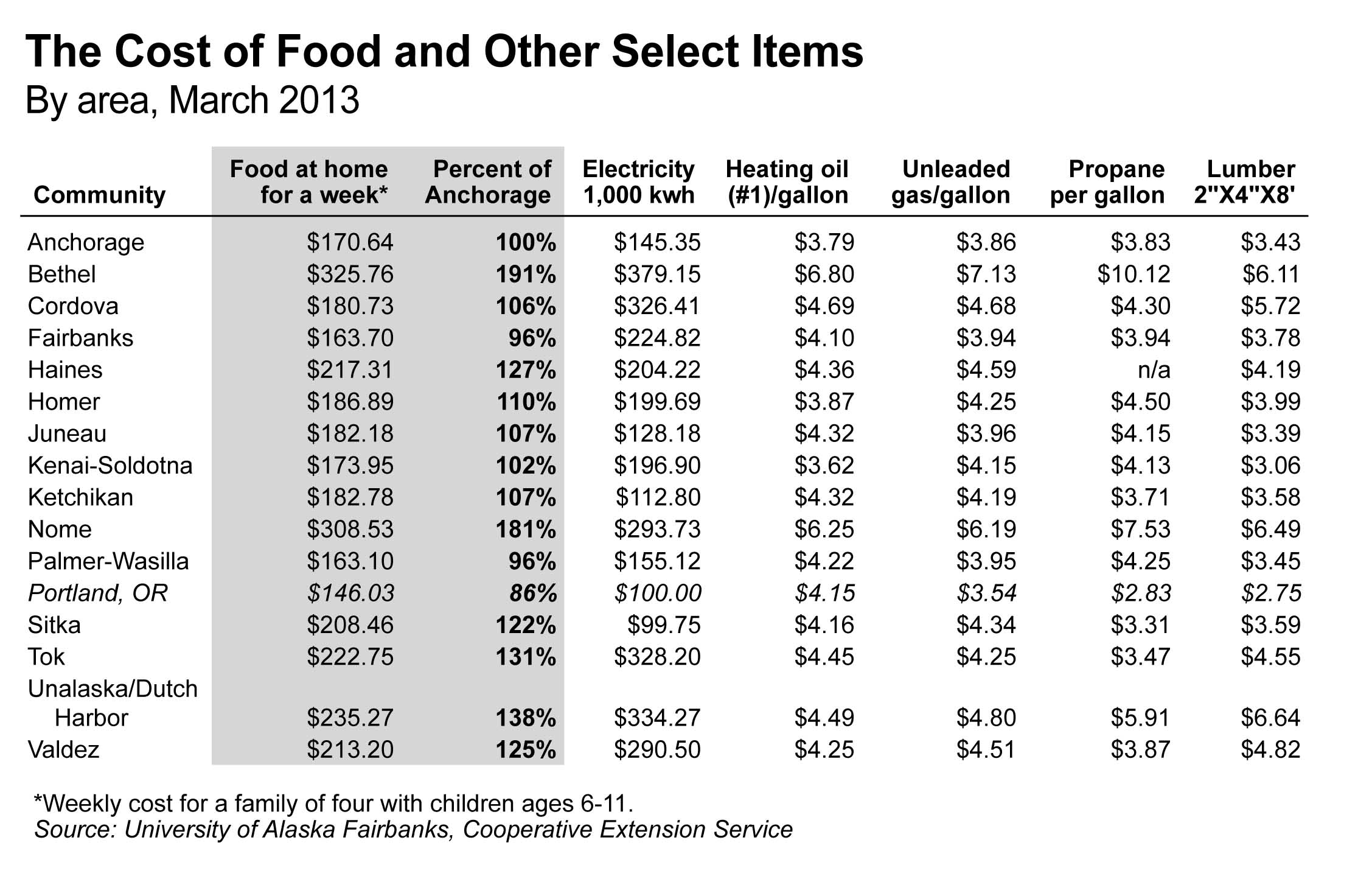Recent figures dissected by economists with the Alaska Department of Labor and Workforce Development show increases in the cost of living in Alaska slowed last year compared to 2011, but the state remains one of the most expensive places in the nation to live and work.
Writing in the department’s monthly magazine, “Alaska Economic Trends,” economist Neal Fried said the state’s only measure of inflation is the Anchorage Consumer Price Index, but, in most cases, price fluctuations in Anchorage “don’t differ radically from other communities in the state.”
According to Fried, the cost of living in Alaska’s largest metropolitan region rose 2.2 percent in 2012, compared to 3.2 percent in 2011. The 10-year-average, he said, was 2.7 percent.
Energy costs tend to drive the CPI’s “volatility,” Fried said. For instance, last year energy costs rose just 1.1 percent, while in 2011, they jumped 10.8 percent. They fell, however, by 7.8 percent in 2009. In the last 10 years, energy prices have more than doubled, compared to a 30-percent jump in the overall CPI, he said.
Unlike Homer and most other rural Alaska communities for which no independent equivalent of the CPI is kept, Anchorage residents mostly rely on cheaper natural gas, as opposed to heating oil. Homer residents currently hooking up to the city’s new natural gas distribution system should begin enjoying falling energy costs soon.
The U.S. Bureau of Labor Statistics compiles the CPI for Anchorage, the smallest of the 26 cities around the country in which it conducts CPI surveys. The surveys look at a “market basket” of items with different locations given different weights, Fried said.
The market basket typically includes housing, food, transportation, medical care, and entertainment, he said. State analysts use a variety of other studies and data sources to compare costs in different Alaska communities. But those data and the index “don’t capture all the differences” in spending habits, Fried noted.
The major expense for most people is housing, which accounts for 41.8 percent of the Anchorage CPI. Transportation is next at 17.4 percent, followed by food and beverages at 15.8 percent, recreation 7.0 percent, medical care 6.6 percent, education and communications 4.7 percent clothing 3.7 percent and “other” at 2.9 percent, according to state figures.
Anchorage’s housing costs often differ from the rest of the nation, and that was evident during the recession when Anchorage had a “relatively healthy” housing market.
“Between 2007 and 2012,” Fried said, “Anchorage housing costs increased by 13.2 percent, while the nation’s rose 6.3 percent. In 2010, the nation’s housing fell while Anchorage’s increased by nearly 1 percent.”
Housing last year was most expensive in Kodiak, Anchorage and Juneau, according to data. For instance, renting a two-bedroom apartment in Kodiak Island Borough cost and average $1,381 per month. In Anchorage, that dwelling cost $1,240, while In Juneau it cost $1,213.
On the Kenai, the same apartment cost just $872 per month.
What the cost of housing and other goods “feels like” also varies community to community. A lot depends on what kinds of jobs might be available. In other words, how many household paychecks does it take to buy an average house? Turns out that under these criteria, it is most expensive to live – where else? – Bethal, where it requires 1.5 paychecks. And, it costs the same in Juneau. Kodiak is slightly less at 1.4 paychecks, and Anchorage requires 1.3 checks.
The Kenai Peninsula Borough at 1.1 checks falls just under the statewide average of 1.2. An Anchorage worker living in a Matanuska-Susitna Borough home needs just 1 paycheck, according to the state.
The average single-family home in the Kenai Peninsula Borough costs $243,474, well below the $342,738 in Juneau or the $340,053 of Anchorage. Again, the KPB falls below the state average of $295,362.
Looking at more mundane items, a Quarter Pounder at McDonald’s costs $4.28 cents in Fairbanks, $4.35 in Anchorage and $4.82 in Juneau before any sales taxes are applied, according to the Council for Community and Economic Research. Those prices are roughly equivalent to places such as Nassau County, N. Y., Boston, Mass., and Providence, R.I.
However, the same Quarter Pounder here in Homer costs $4.79 before taxes, $5.15 once the city’s share is figured in, according to the local McDonald’s.
Some costs are comparable to those in the Lower 48, while others are not, said Fried. A t-bone steak and a six-pack of Heineken cost only a bit more than they do Outside, but you’ll pay significantly more for a visit to the dentist.
Here’s a look at costs for food and other items comparing Homer, Kenai-Soldotna, and Anchorage in March 2013:
In Anchorage, food for a week for a family of four (children ages 6-11) cost $170.64 in March. In Homer, it was $186.89, while in the Central Peninsula a family spent an average $173.95. A thousand kilowatts of electricity cost $145.35 in the big city in March, $196.90 in Kenai and Soldotna, and almost $200 in Homer. Heating oil in Homer was $3.87 a gallon compared to $3.62 in Kenai-Soldotna, and $3.79 in Anchorage. A frequent sore point among Homer residents is the cost of unleaded gasoline. In March a gallon cost $4.25. Meanwhile, consumers paid $4.15 in Kenai-Soldotna and just $3.79 in Anchorage. The differential for propane was even wider, $4.50 per gallon here, $4.13 in Kenai-Soldotna, and $3.86 per gallon in Anchorage. An eight-foot 2X4 cost $3.43 in Anchorage, $3.06 in Kenai-Soldotna, and $3.99 in Homer. The preceding figures were accumulated by the University of Alaska Fairbanks Cooperative Extension Service figures and cited by the state.
Still another way to look at the rising cost of living (using the Anchorage CPI) is to compare how costs have changed since 2000. According to Fried, what it took $1,000 to buy in 2000 now requires $1,364.


